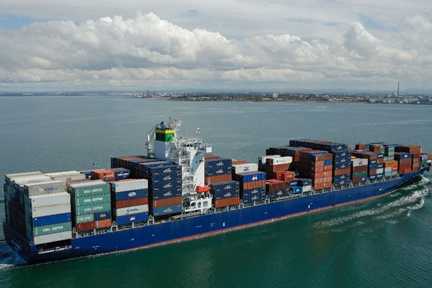Center for Maritime Safety and Health Studies

A container vessel. Photo: Thinkstock
Marine Transportation
Marine transportation workers perform various tasks while working on waterborne vessels that transport goods and people, or perform services. There are a number of sub-industries within marine transportation that use specialized vessels to accomplish specific duties or transport specific cargo. Examples of this include tug and tow boats, barges, container ships, bulk cargo ships, and ferry and cruise passenger vessels.
Marine transportation workers face a variety of unique work hazards1,2. Physical hazards are exacerbated by severe weather conditions, noise levels, vibration, ultraviolet light exposure, line handling, heavy lifting, slippery surfaces, steep ladders, and narrow passageways among others. Chemical hazards include exposures to chemical cargos, fuel, cleansers, and diesel exhaust. Biological hazards include transmission of contagious diseases between coworkers and travel-related infections. Psychosocial hazards remain a significant challenge3-8: with social isolation, language barriers, circadian rhythm disruption, substance abuse, low job control/high demand, harassment/bullying (43% prevalence in Nautilus study)9, and the fear of piracy internationally.
In 2015, there were approximately 68,000 workers in the U.S. water transportation industry10. Inland waterways represents approximately 28,000 workers. Deep Sea, Coastal, and Great Lakes Water Transportation represents approximately 34,000 workers11. From 2011 – 2014, there were 53 fatal injuries (16 per 100,000 workers)12 among marine transportation workers, nearly 6 times the rate of all US workers. Studies show a high burden of fatalities due to cardiovascular conditions, work accidents, drownings (including from vessel disasters), suicides, and workplace violence13,5. BLS data on the US workforce (2011–2015) indicate a substantial number of deaths due to workplace violence and drownings. In the same time period, there were approximately 7,300 nonfatal occupational injuries14 due to slips, trips, and falls, with a high proportion of upper extremity, lower extremity, and back injuries resulting in disability12, representing a rate of injury and illness three times higher than all US workers.15,16
References
- Carter T, Jepsen JR [2014] Exposures and health effects at sea: report on the NIVA course: Maritime Occupational Medicine, Exposures and health Effects at Sea: Elsinore, Denmark, May 2014. International maritime health; 65(3):114-21.
- Oldenburg M, Baur X, Schlaich C [2010] Occupational risks and challenges of seafaring. Journal of Occupational Health; 52(5):249-56.
- Iversen RT [2012] The mental health of seafarers. Int Marit Health; 63(2):78-89.
- Jeżewska M, Leszczyńska I, Jaremin B [2006] Work related stress in seamen. Int Marit Health; 57.
- Roberts SE, Jaremin B, Lloyd K [2013] High-risk occupations for suicide. Psychological medicine; 43(06):1231-40.
- Oldenburg M, Jensen HJ, Wegner R [2013] Burnout syndrome in seafarers in the merchant marine service. International archives of occupational and environmental health; 86(4):407-16.
- Sampson H, Thomas M [2002] The social isolation of seafarers: causes, effects, and remedies. International Maritime Health; 54(1-4):58-67.
- Stannard S, Vaughan C, Swift O, Robinson G, Altaf SA, McGarry A [2015] Women seafarers’ health and welfare survey. Int Marit Health; 66(3):123-38.
- Nautilus International [no date] Report: Bullying, Discrimination & Harassment Survey 2010. Nautilus International, London. Accessed on 6/13/2017, http://m.nautilusint.org/media/169246/Bullying-Discrimination-Harassment-survey-2010.pdf
- BLS [2016] NAICS 483 Water transportation, All states and US, 2015 Annual averages, all establishment sizes. In. Quarterly Census of Employment and Wages. Washington DC: Bureau of Labor Statistics, https://data.bls.gov/cew/apps/data_views/data_views.htm#tab=Tables
- BLS [2016] May 2016 National Industry-Specific Occupational Employment and Wage Estimates. NAICS 483000 – Water Transportation. In Occupational Employment Statistics. Washington, DC: Bureau of Labor Statistics, https://www.bls.gov/oes/current/naics3_483000.htm
- BLS [2016] Census of Fatal Occupational Injuries (2011 forward), all US, all ownerships, water transportation. In Census of Fatal Occupational Injuries. Washington DC: Bureau of Labor Statistics, https://www.bls.gov/data/#injuries
- Roberts SE, Jaremin B, Chalasani P, Rodgers SE [2010] Suicides among seafarers in UK merchant shipping, 1919–2005. Occupational Medicine; 60(1):54-61.
- BLS [2016] Table 2. Numbers of occupational injuries and illnesses by industry and case types, 2011-2014. In Survey of Occupational Injuries and Illnesses. Washington DC: Bureau of Labor Statistics, https://www.bls.gov/iif/oshsum.htm
- Lefkowitz RY, Slade MD, Redlich CA, et al. [2015] Risk factors for merchant seafarer repatriation due to injury or illness at sea. Int Marit Health; 66:61-6.
- Lefkowitz RY, Slade MD, Redlich CA [2015] Injury, illness, and work restriction in merchant seafarers. American Journal of Industrial Medicine; 58:688-96.
- Page last reviewed: May 31, 2017
- Page last updated: July 18, 2017
- Content source:
Error processing SSI file


 ShareCompartir
ShareCompartir